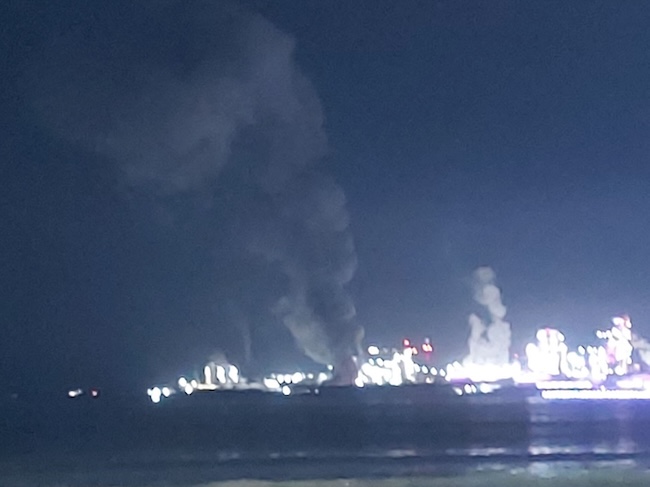
MacroGenics ( MGNX 1.89% ) Q3 2024 Earnings Call Nov 05, 2024 , 4:30 p.m.
ET Contents: Prepared Remarks Questions and Answers Call Participants Prepared Remarks: Operator Good afternoon. We will begin the MacroGenics 2024 third-quarter corporate progress and financial results conference call in just a moment. All participants are on a listen-only mode at the moment, and we will conduct a question-and-answer session at the conclusion of the call.
At this point, I will turn the call over to Jim Karrels, senior vice president and chief financial officer of MacroGenics. James Karrels -- Senior Vice President, Chief Financial Officer, and Secretary Thank you, operator. Good afternoon, and welcome to MacroGenics' conference call to discuss our third quarter 2024 financial and operational results.
For anyone who has not had the chance to review these results, we issued a press release this afternoon outlining today's announcements. This release is available under the Investors tab on our website at macrogenics.com.
You may also listen to this conference call via webcast on our website, where it will be archived for 30 days beginning approximately two hours after the call is completed. I would like to alert listeners that today's discussion will include statements about the company's future expectations, plans, and prospects that constitute forward-looking statements for purposes of the safe harbor provision under the Private Securities Litigation Reform Act of 1995. Actual results may differ materially from those indicated by these forward-looking statements as a result of various important factors, including those discussed in the Risk Factors section of our annual, quarterly, and current reports filed with the SEC.
In addition, any forward-looking statements represent our views only as of today and should not be relied upon as representing our views as of any subsequent date. While we may elect to update these forward-looking statements at some point in the future, we specifically disclaim any obligation to do so, even if our views change, except to the extent required by applicable law. And now, I'd like to turn the call over to Dr.
Scott Koenig, president and chief executive officer of MacroGenics. Scott E. Koenig -- President, Chief Executive Officer, and Director Thank you, Jim.
I'd like to welcome everyone participating via conference call and webcast today. I will provide key updates on our clinical programs this afternoon. But before I do so, let me first turn the call back to Jim, who will review our financial results.
James Karrels -- Senior Vice President, Chief Financial Officer, and Secretary Thank you, Scott. This afternoon, MacroGenics reported financial results for the quarter ended September 30, 2024, which highlights our financial position. As described in our release this afternoon, MacroGenics' total revenue was $110.
7 million for the quarter ended September 30, 2024, compared to total revenue of $10.4 million for the quarter ended September 30, 2023. The increase was primarily due to $100 million in milestones received from Incyte in August related to retifanlimab.
Our research and development expenses were $40.5 million for the quarter ended September 30, 2024, compared to $30.1 million for the quarter ended September 30, 2023.
The increase was primarily due to increased research and development costs related to the company's preclinical ADC pipeline of vobra duo and the TAMARACK clinical trial. Our selling, general, and administrative expenses were $14.1 million for the quarter ended September 30, 2024, compared to $12.
4 million for the quarter ended September 30, 2023. The increase was primarily due to increased stock-based compensation expense and professional fees. Our net income was $56.
3 million for the quarter ended September 30, 2024, compared to net income of $17.6 million for the quarter ended September 30, 2023. Net income for the quarter ended September 30, 2024, included the aforementioned $100 million in milestones from Incyte.
Net income for the quarter ended September 30, 2023, included a $50 million milestone payment from Sanofi related to the previously disclosed achievement of a primary endpoint in a TZIELD clinical study, which was recorded in other income. Our cash, cash equivalents, and marketable securities balance as of September 30, 2024, was $200.4 million compared to $229.
8 million as of December 31, 2023. The balance of September 30, 2024, did not include the $40 million upfront payment anticipated from the closing of the MARGENZA transaction or the $8 million amendment fee we plan to pay our current commercialization partner. Finally, in terms of our cash runway.
Consistent with our prior guidance, we anticipate that our cash, cash equivalents, and marketable securities balance of $200.4 million as of September 30, 2024, plus the $40 million upfront payment anticipated from TerSera related to the MARGENZA transaction, less an $8 million amendment fee we expect to pay our current commercialization partner, in addition to projected and anticipated future payments from partners should provide a cash runway into 2026. Our anticipated funding requirements reflect expected expenditures related to the ongoing Phase 2 TAMARACK and LORIKEET studies as well as our other ongoing clinical and preclinical studies.
And now, I'll turn the call back to Scott. Scott E. Koenig -- President, Chief Executive Officer, and Director Thank you, Jim.
We continue to believe our proprietary pipeline of product candidates has great promise, and I will walk you through each of our key programs. Vobramitamab duocarmazine, or vobra duo, is our ADC designed to deliver a DNA-alkylating duocarmycin cytotoxic payload to tumors expressing B7-H3. B7-H3 is a member of the B7 family of molecules involved in immune regulation.
Vobra duo is designed to take advantage of this antigen's broad expression across multiple solid tumor types. We continue to believe B7-H3 has the attributes of an ideal cancer target. The TAMARACK Phase 2 study is being conducted in mCRPC patients who have previously received an androgen receptor access targeted agents and up to one prior taxane-containing regimen but no other chemotherapy.
While study participants are no longer being dosed in the trial, participants continue to be monitored for adverse events, disease progression, and survival. The study's primary endpoint is radiographic progression-free survival, or rPFS. Given that only 65 PSF events or 35.
9% had accrued as of the July 9, 2024, data cutoff, the interim medium rPFS estimates presented at the ESMO Congress in September were immature. And because these results were immature, we believe they are likely to change as additional events accrue. We expect to have mature median rPFS in hand no later than early 2025.
Assessment of future development alternatives for vobra duo will be based on several factors, including the final TAMARACK safety and efficacy data in mCRPC, a review of the competitive treatment landscape for mCRPC, resource allocation across our clinical portfolio, as well as potential partnering opportunities for vobra duo. Until we complete our assessment of the monotherapy development opportunity in mCRPC, we have paused our other development efforts in alternative tumor types as well as the Phase 1/2 dose combination study of vobra duo plus lorigerlimab. Recall that we have two other clinical molecules that target B7-H3.
The first, MGC026, is an investigational ADC incorporating a novel topoisomerase 1 inhibitor-based linker payload, SYNtecan E, which we licensed from Synaffix. Our second additional B7-H3-directed molecule is enoblituzumab, the investigational Fc-optimized monoclonal antibody. MGC026 incorporates a linker payload based on exatecan, a clinically validated and potent camptothecin that readily combines with Synaffix's hydrospace technology.
We initiated a Phase 1 dose escalation study of MGC026 early this year in patients with advanced solid tumors. The variable domain of the molecule targeting B7-H3 for MGC026 is the same sequence contained in vobra duo. We view the MGC026 as a complementary approach to vobra duo for targeting B7-H3.
More specifically, we believe that having distinct mechanisms of action and potentially different safety and efficacy profiles, vobra duo and MGC026 may address different cancers, tumor stages or be used in combination with alternate agents or potentially with one another to enhance their clinical utility. We remain confident in the potential of targeting the B7-H3 pathway regardless of the mechanism of action or payload. Regarding enoblituzumab, our academic collaborators are enrolling the HEAT study an investigator-sponsored, randomized Phase 2 study of this molecule in up to 219 men with prostate cancer.
Next, I'll update you on lorigerlimab, our bispecific tetravalent PD-1 x CTLA-4 DART molecule. We designed lorigerlimab to have preferential blockade on dual PD-1 CTLA-4 expressing cells, such as tumor-infiltrating lymphocytes, or TILs, which are most abundant in the tumor microenvironment. We are enrolling the LORIKEET study, a randomized Phase 2 clinical trial of lorigerlimab, in combination with docetaxel versus docetaxel alone in second-line chemotherapy naive and CRPC patients.
The current study design includes the primary study endpoint of rPFS. A total of 150 patients are planned to be treated in a two-to-one randomized study with more than 100 study participants enrolled to date. We anticipate completing enrollment of the study late this year or early 2025 and providing a clinical data update on the study in the first half of 2025.
MGD024 is our next-generation bispecific CD123 by CD3 DART molecule that incorporates a CD3 component designed to minimize cytokine release syndrome while maintaining anti-tumor cytolytic activity and permitting intermittent dosing through a longer half-life. Our Phase 1 dose escalation study of MGD024 is ongoing in patients with CD123-positive relapsed or refractory hematologic malignancies, including acute myeloid leukemia and myelodysplastic syndromes. Recall that Gilead has the option to license MGD024 at predefined decision points during the Phase 1 study.
MGC028 is our second topoisomerase 1 inhibitor-based ADC incorporating Synaffix's novel linker payload and an ADAM9 targeting antibody. ADAM9 is a member of the Adams family of multifunctional type 1 transmembrane proteins that play a role in tumor genesis and cancer progression and is overexpressed in multiple cancers, making it an attractive target for cancer treatment. We recently submitted an investigational new drug application for MGC028 to the U.
S. FDA. Beyond MGC028, we are exploring additional molecules for potential future IND submission.
I look forward to telling you more about these additional molecules on future calls. Finally, after quarter-end, we sold global rights to margetuximab, which is marketed as MARGENZA, to TerSera Therapeutics LLC, a privately held biopharmaceutical company, pursuant to an agreement announced a few weeks ago. TerSera is expected to pay us $40 million at closing, and we may receive additional sales milestone payments of up to an aggregate of $35 million.
The transaction is expected to close in the fourth quarter of 2024, subject to customary closing conditions. We expect to pay an $8 million amendment fee to our current commercialization partner during the fourth quarter of 2024 and will manufacture MARGENZA drug substance on behalf of TerSera going forward. The pending margetuximab transaction, as well as the recently received $100 million in milestones from Incyte, further strengthen our financial position, enabling us to sharpen our focus on our key priorities of advancing our clinical-stage assets while researching and developing the next wave of early stage product candidates.
Thank you all for joining today. As you know, we announced last week that I will be stepping down as President and CEO early next year. After nearly 25 years with MacroGenics, it's truly a milestone for me personally and professionally.
Together, we've transformed ideas into treatments, building a fully integrated biotech company dedicated to helping patients. I'm immensely proud of what we've achieved, particularly the advancement of therapeutics like MARGENZA, ZYNYZ, and TZIELD to FDA approval and our robust pipeline of antibody-based treatments. This transition comes at a time when MacroGenics is strongly positioned with a diverse and promising development portfolio and a solid financial foundation.
The board has initiated a thoughtful search for my successor, and I am committed to supporting the company during this period to ensure a seamless transition. Looking ahead, I am confident in MacroGenics' future. Our near-term goals remain unchanged: advancing our pipeline, expanding partnerships, and creating value for patients and shareholders alike.
I want to thank the MacroGenics team, our board, our shareholders, and our partners for their dedication. I look forward to continuing my support as an advisor and shareholder, and I'm excited to see all that MacroGenics will accomplish in its next chapter. We would now be happy to open the call for questions.
Operator? Questions & Answers: Operator Thank you. [Operator instructions] Please stand by while we compile the Q&A roster. Now, first question coming from the line of Tara Bancroft with TD Cowen.
Your line is now open. Unknown speaker -- -- Analyst Hey, guys, this is Nick on for Tara. Thanks for taking our question.
Just one for me, but I understand the parameters factoring into your excision will be multiple for this. But what do you need to specifically see from the data next year to make a decision about going forward or not for vobra duo? And do you have any updated thoughts on the potential dose at this point? Thanks. Scott E.
Koenig -- President, Chief Executive Officer, and Director Thank you very much, Nick. As we said, we are close to getting the final data. As we've noted, we continued the observation of these patients post the last dosing, which occurred in July.
The patients will be followed no longer than six more months. As I pointed out, the number of parameters to look at, obviously, looking at the final rPFS, looking at the safety profile of the drug, looking at the competitive landscape, and assessing this in the context of other things we have in our portfolio. It's just too early at this point to give the specific parameters which will determine next steps forward.
So, be patient, and we should be able to provide some insights in the coming months. Unknown speaker -- -- Analyst Thank you very much. Operator Thank you.
Our next question coming from the line of Jonathan Chang with Leerink Partners. Your line is now open. Jonathan Chang -- Leerink Partners -- Analyst Hi, guys.
Thanks for taking my questions. And of course, best wishes to Scott. First question, on that point, can you provide any color around the search process for the next CEO? And how we should be thinking about timelines for the transition? And then second question, on MGC026, your second B7-H3 ADC program.
Can you discuss how the Phase 1 dose escalation is progressing? And when could investors see initial clinical data from that program? Thank you. Scott E. Koenig -- President, Chief Executive Officer, and Director First, Jonathan, thank you very much.
It's always been a pleasure working with you. In terms of the search process, as the announcement occurred last week, the -- there is a subgroup of the board that has been selected to initiate the process while a search committee is going to be working with an outside firm, and that process is just getting started. The expectations, as I said, is that I will stay on.
We're going to continue with the strategy we have adopted and move the programs forward until the new CEO is selected. It's anticipated. Obviously, these things take a few months.
I will stay on until the new CEO is selected so there should be a smooth handoff to anyone when that person comes on board. With regard to the 026 study, we're in the middle of dose escalation. The study is going quite well.
We're getting into ranges right now. One might anticipate the beginning of responsiveness. The expectation here is that we would begin -- we would complete this study in '25 and be able to report the data out in '25.
Jonathan Chang -- Leerink Partners -- Analyst Understood. Thanks for taking the questions. Operator Thank you.
And our next question coming from the line of Yigal Nochomovitz with Citi. Your line is now open. Unknown speaker -- -- Analyst Hi.
This is Reena on for Yigal. I just wanted to ask what kind of triggered the decision to halt the combo now versus earlier when the decision was seen to stop dosing patients in TAMARACK. And if you could provide any more details on the color on pausing the lorigerlimab combo with vobra, how many patients were dosed? Were there any issues reminiscent of what we've seen in the vobra monotherapy? Or just any additional color you might have there? Scott E.
Koenig -- President, Chief Executive Officer, and Director Thank you very much for the question. As you know, we had proceeded with the combo study to the point where we were very comfortable with the doses that were achieved in the populations we were examining with the individual lorigerlimab and vobra in combination. However, as we pointed out, is that we are looking at the final data for TAMARACK coming up in the next couple of months.
We would look at the possibility of exploring additional studies in vobra to fine-tune that, if appropriate. And therefore, rather than continue moving forward and expansions with the doses that we had already tested in combination, we wanted to get that final assessment of the appropriate vobra dose before we would then explore combinations going forward. So, it's a judgment that we want to ultimately have the best dose going forward if we continue combination studies.
Unknown speaker -- -- Analyst OK. That makes sense. Thanks for taking my question.
Operator Thank you. And our next question coming from the line of Etzer Darout with BMO Capital Markets. Your line is now open.
Etzer Darout -- BMO Capital Markets -- Analyst Thanks for taking the question. Just one question for me on MGC026. Just wonder, given now you've evaluated vobra duo preclinically and in the clinic.
You've gotten a preclinical assessment of MGC026. If you're seeing any notable differences in the profile for those two ADCs from a safety perspective and how that profile could be differentiated from vobra on sort of safety? Thank you. Scott E.
Koenig -- President, Chief Executive Officer, and Director Thanks, Etzer. One would expect that, obviously, with vobra being a DNA-alkylating agent and the 026 being a topo 1 inhibitor, one will see distinct safety profiles. As I've said, we want to get the final safety.
We obviously achieved much with the TAMARACK study with lowering the doses there. But at this point, being only in the middle of dose escalation on 026, I can't give you a side-by-side comparison of the two. There will be distinct differences in safety, but it's just too early to spell out the specifics at this point.
Etzer Darout -- BMO Capital Markets -- Analyst Thank you. Operator Thank you. Our next question coming from Jon Miller with Evercore ISI.
Your line is now open. Jon Miller -- Analyst Hi, guys, thanks for taking the question, and I'll echo my respect for Scott, and as you've heard before, great to work with you for all these years. I'd also love to ask about the vobra-lori combo that you're pausing.
How many patients have you dosed there? How much data do you have? And is there any chance we could see that data? Maybe around the same time that lori is coming out or in the near term at any rate? And maybe from a LORIKEET perspective, how do you view the landscape for lori combinations going forward from here, whether it's with vobra duo or with other ADCs in prostate? Scott E. Koenig -- President, Chief Executive Officer, and Director Yeah. Thanks so much, Jon.
I really appreciate the personal comments. It is a pleasure to be working with you and your colleagues as well. With regard to the number of patients, we did many -- and the actual specific numbers I can't answer to you off the top of my head.
But is in the double digits. In terms of looking at multiple doses, this was a three-plus-three assessment at various combinations. But of course, because we were enrolling patients with different tumor types, the representation of any particular tumor type was quite small.
So, at this point, we haven't assessed the form of presenting the data we have there is more likely that, as I said earlier, we want to assess the final results of TAMARACK, make some decisions, whether we need further alterations of the vobra dosing if we continue with the combination studies going forward. With regard to the opportunity with lorigerlimab, as you know, we are doing the LORIKEET study in combination with docetaxel. And as I noted earlier, that study will completely enroll by the end of the year or very early in '25.
So, we'll have data on '25 on that. And we are looking at opportunities of combining lorigerlimab and other clinical settings, not only in prostate cancer, with other agents, but it's, again, too early to assess that until we have the final data on the LORIKEET study. James Karrels -- Senior Vice President, Chief Financial Officer, and Secretary Let me just add to that, just in case it wasn't completely clear to listeners.
So, the -- with regard to vobra plus lori, that combination, we've only studied that in dose escalation. We had thought we would move into dose expansion later this year. Obviously, we did not do that.
So, all of our data comes from dose escalation, and the dose expansion study was never actually commenced. Scott E. Koenig -- President, Chief Executive Officer, and Director Yeah.
As Jim was pointing out, again, it was a three-plus-three design in looking at that. Operator Thank you. And our next question coming from the line of Kelsey Goodwin with Guggenheim Partners.
Your line is now open. Unknown speaker -- -- Analyst Hi, this is Brittany on for Kelsey. Thank you for taking our questions about the LORIKEET trial and the update that's coming in the first half of next year in terms of the benchmark there and what would be considered.
Scott E. Koenig -- President, Chief Executive Officer, and Director Yeah. Thanks very much with regard to the LORIKEET study.
You were a little soft on the sound here. I just want to make sure everybody understood what the question was. Clearly, we're looking here at a chemo-naive population.
As you know, if you look at the standard of care of docetaxel alone, if you look at the last three studies where docetaxel was tested, it's approximately eight to 8.6 months of rPFS benefit. Clearly, we would like to see a significant increase, both in rPFS and then ultimately, obviously, have a benefit seen in OS, the actual number.
We are not in a position to declare at this point, but certainly would be in a -- for rPFS, will be certainly in a double-digit months of improvement. Operator Thank you. And our next question coming from the line of Silvan Tuerkcan with Citizens JMP.
Your line is open. Silvan Tuerkcan -- Analyst Yeah. Thank you.
Thanks for taking my question. And Scott, thank you for working with us. It was great to work with you.
I have a question on MGD024. You've mentioned that Gilead has some opt-in at various points throughout this trial, and it is ongoing, and you may or may not get data next year. But are any of those points next year -- could we find out next year for the option or not? Thank you.
Scott E. Koenig -- President, Chief Executive Officer, and Director Yeah. You know, it's -- thank you very much, again, to your personal comments.
With regard to the study, it's proceeding well. As you know, with an active redirected T-cell killing molecules, the FDA position is that one requires slow dose escalation. And we've been through many, many cohorts already, and we are continuing to dose escalate here.
So, I can't, at this point, determine when the study will be completed. It is moving forward. And nor can I determine when Gilead might make the decision with regard to opting in.
They have the ability to wait until the end of the Phase 1 data. So, at this point, though, we have a very good collaboration. We share the data with them, and we expect that the study will continue.
Operator Thank you. And our next question coming from Mayank Mamtani with B. Riley Securities.
Your line is now open. Mayank Mamtani -- B. RIley Financial -- Analyst Good afternoon.
Thanks for taking our questions, and congrats to Scott for a long list of accomplishments. You'll be missed. One big-picture question.
You've tended to focus as an organization on prostate cancer. Could we see a bit of a strategy shift in terms of as you get to this next chapter for MacroGenics? And relatedly, if you're able to give us a precise guidance, kind of when -- and if at all, next year, we could see both CRPC and maybe lung cancer-specific data for to assess direct comparability to both your program and the PRB 73 programs also getting to late-stage development? And then I have a follow-up. Scott E.
Koenig -- President, Chief Executive Officer, and Director Yeah. Thank you very much, again, for the personal comments as well. With regard to the prostate cancer, we are a company that is strongly focused on developing a wide range of treatments for solid tumors.
We embarked on prostate cancer a number of years ago because of the opportunities there and the lack of appropriate treatments, particularly for late-stage patients. There certainly was a need there, and that obviously led to the development of multiple molecules which we're pursuing. As you know, the B7-H3 programs as well as lorigerlimab.
And we will continue with that. And I've discussed the results that we expect over the course of 2025. With regard to 026, as we've talked about vobra duo.
So, with 026, we're looking at the use of this drug in a lot of different tumor types. The dose escalation is open to a wide range of B7-H3-positive tumors. The plan going forward is to determine patients that have responses to 026 in the dose escalation we have built into the Phase 1 study, the ability to do many expansions.
And so, as a result, with regard to responses in prostate for 026, we expect that we should have data in other tumor types as well. But at this point, again, as I indicated, we're only in the middle of dose escalation, and it's too early to determine what specific tumor types we might pursue further. Mayank Mamtani -- B.
RIley Financial -- Analyst Great. And then one specific question regarding the TAMARACK learnings. The efficacy of VHD is generally comparable post taxane.
I was wondering if this could be because of B7-H3 expression and its maintained expression pre and post tumor, which could be different than say, PSMA. And is your expectation going forward that remains the case as you intend to report the final TAMARACK data? Scott E. Koenig -- President, Chief Executive Officer, and Director Yeah.
So, we are continuing to look at, obviously, both the chemo-naive and the post-taxane settings for the TAMARACK data. As we showed at ESMO and indicated, we are having at the landmark time frame of six months, we're getting very good responses in both the chemo-naive as well as the chemo-experienced population. So, at this point, until we have the final data, we haven't assessed if we pursue this further.
Again, as I pointed out earlier, there are a lot of things that we will assess when we have the final data. But right now, it's still open to providing a potentially new paradigm for treatment, both in the chemo-experienced as well as the chemo-naive population. All comes down to the degree of activity, the rPFS, as well as the safety profile.
Mayank Mamtani -- B. RIley Financial -- Analyst Understood. And lastly, for the LORIKEET trial enrollment getting to completion here, Scott.
Are you able to comment on how maybe the patient baseline characteristics, prior treatment exposure, VSM status could compare relative to docetaxel trials that have been done in mCRPC previously? And could you just clarify if the OS results will also be available next year? Or would that take longer? Scott E. Koenig -- President, Chief Executive Officer, and Director With regard to the characteristics of the LORIKEET, I would say that the population for these chemo-naive patients was quite similar to what was enrolled in the patients for TAMARACK. So, they obviously had progression on an androgen receptor targeting agent.
And so, we think that this will be a population that is very characteristic of what is normally seen there for patients who are on the standard regimen would get docetaxel. The fact that we have this as a controlled trial, we will have our own data to see what docetaxel does alone in the 50 patients or so that are treated with that agent alone as compared to historical data. So, I'm feeling pretty confident that we will have a data set that will be nicely valuable as compared to historical studies.
Now, with regard to overall survival, I think it will be too early to be able to report that out in '25. But given that, as we said, the study will be completely enrolled by the end of this year or very early in '25, I think we'll be in very good shape to present, obviously, responses, PSA reductions as well as rPFS in '25, but OS, maybe a little early. Mayank Mamtani -- B.
RIley Financial -- Analyst Thanks again for taking the questions. Operator Thank you. And our next question coming from the line of Peter Lawson with Barclays.
Your line is now open. Peter Lawson -- Analyst Great. Thank you so much.
I guess as we think about your B7-H3 assets, I guess your second-generation molecule, how far behind is that when do we see the initial data? And kind of what do you want to see in that, I guess, your first generation B7-H3 to kind of understand if that and how that moves forward? Scott E. Koenig -- President, Chief Executive Officer, and Director Thank you very much, Peter. To comment, as you know, there are a number of other molecules that are moving forward.
For topo 1 inhibitors, the data has been presented in a number of different scientific forms. Again, we see many of the virtues of the way 026 was designed with regard to having a site-specific conjugation of the Synaffix exatecan with the DAR4 and with other profiles that despite the fact that we may be behind in that particular molecule development as compared to others that we feel that the opportunity here is that this could perform quite well. And then obviously, because of the broad expression of B7-H3 in different tumor types, the data that's been presented to date for competing molecules has been in a limited number of tumor types.
And so, despite the fact there has been data that has been shown particularly in small cell cancer and in some cases, modest data in other lung cancers, we feel that we can be quite competitive with the 026 molecule once we finish dose escalation. And as I said earlier, we expect that data from the Phase 1 study to be available in '25. With regard to the vobra duo molecule, again, it's just too early to spell out the opportunity here.
Clearly, we have the largest data set in prostate cancer with vobra duo, but we will have to assess again what is necessary to achieve a go-forward plan based on the final rPFS data as well as the final safety profile and whether further tweaking will be necessary for the dosing to move forward into a prostate indication. So, stay tuned. We're still very encouraged by the prospects of both of our B7-H3 ADC molecules.
Peter Lawson -- Analyst Great. Thank you so much, Scott. And Scott, it's always been a pleasure talking to you over the year.
So, thanks for all those conversations. Scott E. Koenig -- President, Chief Executive Officer, and Director Thank you very much.
And same here. I've had the same feeling. Operator Thank you.
[Operator instructions] Our next question coming from the line of Stephen Willey with Stifel. Your line is now open. Stephen Willey -- Analyst Yeah, good afternoon.
Thanks for taking the questions. First, I just wanted to say best of luck to you, Scott. I have certainly enjoyed all the interactions over the years.
And then second, just a quick question on MGC028. Just curious as to whether or not the Phase 1 dose escalation program is going to be prespecifying for specific tumor types. If I remember correctly, I think ImmunoGen had outlined a few different tumor types that it was interested in as it ran that Phase 1 development program.
I know that you were a partner with them, obviously. But just wondering if that list of tumor types has changed, just given that you've stopped the payload out, there's obviously an inherent sensitivity of different tumors to different payloads. And would be curious if you could just give some information as to what tumors you're thinking about.
Thanks. Scott E. Koenig -- President, Chief Executive Officer, and Director Yeah.
Thanks, Steve. And again, a real pleasure, always working with you over the years. The answer is yes, we are going to limit the specific tumor types going forward.
As you know, in particular, this -- based on our own preclinical data as well as IHC data, we've shown overexpression in a number of tumor types. So, one among the tumors that you could expect would be obviously lung cancer and pancreatic cancer, and at least another tumor type as well. So, we feel that that will give us the best sense as we dose escalate to be able to see activity signals as well as obviously the safety profile of the drug.
As you know, one of the challenges on the ImmunoGen molecule is that we were never able to achieve the targeted dose because of the high toxicity that was observed. Stephen Willey -- Analyst All right. Thanks for the question.
Operator Thank you. And at this time, I see no further questions in the Q&A queue. I will now turn the call back over to Dr.
Koenig for any closing remarks. Scott E. Koenig -- President, Chief Executive Officer, and Director Well, again, thank you, everyone, for your kind remarks personally.
And obviously, we look forward to providing updates on our exciting programs and other company-related activity on our next earnings call. And go out and vote if you haven't done it already. James Karrels -- Senior Vice President, Chief Financial Officer, and Secretary Good night, everyone.
Operator [Operator signoff] Duration: 0 minutes Call participants: James Karrels -- Senior Vice President, Chief Financial Officer, and Secretary Scott E. Koenig -- President, Chief Executive Officer, and Director Jim Karrels -- Senior Vice President, Chief Financial Officer, and Secretary Scott Koenig -- President, Chief Executive Officer, and Director Unknown speaker -- -- Analyst Jonathan Chang -- Leerink Partners -- Analyst Etzer Darout -- BMO Capital Markets -- Analyst Jon Miller -- Analyst Silvan Tuerkcan -- Analyst Mayank Mamtani -- B. RIley Financial -- Analyst Peter Lawson -- Analyst Stephen Willey -- Analyst More MGNX analysis All earnings call transcripts.












